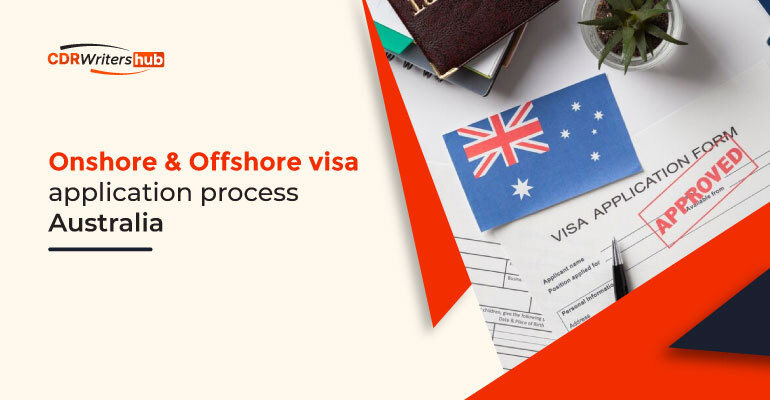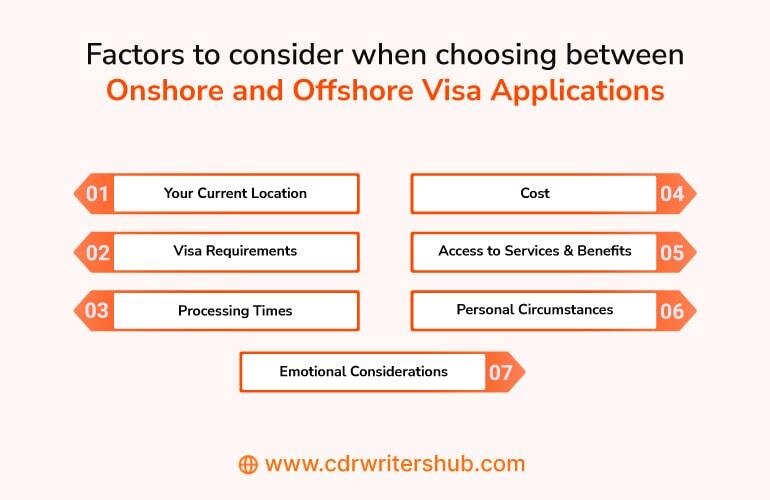Onshore and Offshore visa application process Australia

Onshore and Offshore visa application process Australia
Moving to Australia, a land of breathtaking landscapes, unique wildlife, and diverse opportunities, is a dream for many of us. However, achieving this dream involves understanding the complex visa application process.
When planning your Australian adventure, one of the most critical decisions you’ll need to make is whether to apply for your visa: onshore and offshore visa application. This blog will help you choose between these two approaches for your Australian adventure by explaining their differences, advantages, and challenges.
Australian Immigration Trend
Table of Contents
Australia is well-known because it has a good life, a strong economy, and great healthcare and education. The country offers many pathways for individuals seeking to live, work, study, or reunite with their loved ones. One of the most popular ways to enter Australia is through partner visas.
Partner visas let people come to Australia to be with their Australian, permanent resident, or eligible New Zealand citizen partners. You can classify these visas into two main types: onshore and offshore visa applications. To choose the right one for your situation, it’s essential to understand the differences between them.
What Are Onshore Partner Visas?
An onshore visa application is when you are already in Australia when you apply for a visa. If you choose the onshore option, you’ll receive a Bridging Visa, and this visa lets you stay in Australia while they process your main visa. There are different types of Bridging Visas, each with specific conditions.
While processing your main visa application, some visas may stop you from leaving Australia. Others may only permit you to work once authorities approve your primary visa. It’s important to note that onshore applications usually take longer to process than offshore applications, and they may involve higher fees.
On shored detection and processing
The Migration Act says that anyone in Australia without a valid visa must get held in detention, no matter what. If you’re in detention as an unlawful non-citizen, you have to stay there until you get a visa or the authorities send you out of Australia.
This strict detention policy in Australia has raised concerns globally. The United Nations Human Rights Committee has stated that Australia is not meeting its international obligations under the ICCPR (International Covenant on Civil and Political Rights).
Onshore Partner Visa
The onshore partner visa process consists of two main stages: the Temporary Partner Visa and the Permanent Partner Visa.
1. Temporary Partner Visa (Subclass 820)
The first stage, the Temporary Partner Visa (Subclass 820), allows you to live in Australia with your partner for up to two years. For this visa, you must be in Australia when you apply and when they decide. If you already have a visa when applying for this visa, you’ll get a Bridging Visa to stay in Australia while they process your partner visa application.
2. Permanent Partner Visa (Subclass 801)
The second stage is the Permanent Partner Visa (Subclass 801), which permits you to live in Australia with your partner. You can apply for this visa two years after applying for the Temporary Partner Visa.
To get the Subclass 801 visa, you have to apply while you’re in Australia. But when they make the decision, you can be in or outside the country.
Advantages of Onshore Visa Applications
Below are some advantages of onshore visa applications:
1. Access to Medicare
One of the significant advantages of applying for an onshore partner visa is access to Medicare. This means you’ll have medical coverage during your stay in Australia, providing peace of mind in case of unexpected health issues.
2. Flexibility and Convenience
The onshore partner visa application process is flexible and convenient if you are already in Australia. You can continue to live, work, and study in the country during the processing period, and the Bridging Visa allows you to maintain a normal life.
3. Bridging Visas
The Bridging Visa you receive as part of your onshore application offers various benefits. It allows you to work and study full-time, and it can also accommodate your international travel requirements. If you need to travel outside Australia during the application process, you can apply for a Bridging Visa B (BVB), which facilitates your re-entry into the country.
Challenges of Onshore Visa Applications
1. Longer Processing Times
Onshore applications generally take longer to process compared to offshore applications. The processing times can vary depending on various factors, such as the type of visa and the complexity of your application.
2. Higher Fees
The cost of onshore applications can be higher due to the increased cost of living in Australia. This includes not only the visa application fees but also the expenses associated with living in the country during the processing period.
What Are Offshore Partner Visas?
An offshore visa application is when you are outside of Australia when you apply for a visa. When they grant your visa, you should be outside Australia. But that doesn’t mean you can’t visit Australia before your visa gets approved. You can get an Australian visiting visa and continue your application process.
When the Australian migration department is ready to finish your application, they will inform you, and then you can leave Australia for the visa processing. You don’t have to return to your home country; you can consider a vacation to New Zealand or any other location outside Australia.
The advantage of offshore applications is shorter processing times for the provisional stage. Also, it usually takes around 13 months to decide. But, a drawback is that you may have to live apart from your partner for at least one year.
Offshore Partner Visa Process
The offshore partner visa process also consists of two main stages: the Provisional Visa (Subclass 309) and the Permanent Visa (Subclass 100).
1. Provisional Visa (Subclass 309)
The first stage of an offshore partner visa application is the Provisional Visa (Subclass 309). This is a temporary visa that allows you to live with your partner in Australia while you apply for the permanent stage of the visa. To be eligible for this visa, you must apply while you are outside Australia. The key distinction here is that this stage of the application process begins outside of Australia.
2. Permanent Visa (Subclass 100)
The second stage of the offshore partner visa application is the Permanent Visa (Subclass 100). This visa grants you the right to live in Australia with your partner. Like the provisional visa, you need to apply for this visa from outside Australia. But once they approve the visa, you can be in Australia or in another country.
More Visa Options to Explore
-
Prospective Marriage Visa
If you’re engaged to an Australian citizen and plan to marry, the Prospective Marriage Visa is for you. This visa allows you to come to Australia to get married and live with your partner as a spouse after the wedding. This visa is valid for nine months, and it’s essential to tie the knot within that period to apply for a spouse visa later.
-
Bridging Visa
When applying for an Australian onshore visa, your current visa could expire before the approval of the next one. In such cases, a Bridging Visa becomes a valuable solution. Think of it as a temporary bridge that allows you to stay in Australia while your visa paperwork is being processed. This way, you can avoid any legal issues related to unauthorized houses.
Bridging visas come in different types, each with its benefits and restrictions. Some may grant permission to work, while others may not. Certain bridging visas also determine whether you can travel.
Factors to consider when choosing between Onshore and Offshore Visa Applications
When choosing between onshore and offshore visa applications, consider these essential factors:
-
Your Current Location
The first factor to consider is your current location. If you are already in Australia, the most convenient option is to apply for a visa onshore. Yet, if you are abroad and have yet to be in Australia, the offshore application may be more suitable for your situation.
-
Visa Requirements
Different types of visas have varying eligibility criteria. It’s crucial to research and understand the specific requirements for your chosen visa category. Ensure that you meet the criteria for an onshore and offshore visa application, as this will be a determining factor in your decision.
-
Processing Times
Processing times can vary between onshore and offshore visa applications. If timing is a critical factor for you, consider how you need your visa and which application type is likely to provide the fastest processing time.
Keep in mind that external factors, such as the type of visa and the volume of applications in process, can also impact processing times.
-
Cost
Cost is another critical consideration. Onshore visa applications are pricier than offshore ones because Australia has a higher cost of living. Considering budget constraints, consider whether the offshore option is more cost-effective.
-
Access to Services and Benefits
Onshore visa applicants may have access to certain services and benefits that are unavailable to offshore applicants. These services can include healthcare coverage (Medicare), educational opportunities, and more.
-
Personal Circumstances
Your circumstances, such as your employment, family, or other commitments, can influence your choice between onshore and offshore applications. For example, if you have a job in Australia and wish to avoid disruptions to your work, an onshore application may be the most appropriate option.
-
Emotional Considerations
Pay attention to the emotional aspects when making this choice. Consider how you and your partner feel about potential separation if you choose an offshore application.
Hence, understanding the differences between onshore and offshore visa applications in Australia is crucial for anyone considering immigration to this beautiful country. Each approach has unique advantages and challenges tailored to diverse circumstances and preferences.
Steps for Getting an Offshore Visa Application
Getting an offshore visa involves several steps, much like an onshore visa. Here’s the process to follow for applying for an offshore visa:
Step 1: Choose Your Visa Type.
Your journey starts with selecting the type of visa you want. You can find a comprehensive list of visas on the Department of Home Affairs website.
Step 2: Verify Eligibility
Before applying for a visa, it’s crucial to ensure you meet the eligibility criteria. Each visa comes with its set of prerequisites, and you must fulfill them to be eligible.
Step 3: Gather Required Documents
Once you’ve decided on the visa and checked the eligibility criteria, the next step is to gather all the necessary documents. The documents you need will vary depending on the type of visa you’re applying for.
Step 4: Lodge Your Application
You can lodge your application online or in person at an Australian embassy, high commission, or consulate. Remember that you’ll need to pay the visa application fee when you submit your application.
Step 5: Await the Decision
After submitting your application, you’ll have to wait for a decision. The visa processing time can differ based on the visa type you’ve applied for.
Why Choose CDRWritersHub?
There are several reasons to consider CDRWritersHub for your onshore and offshore visa application:
- Expertise: CDRWritersHub and similar services have experts who know Australian immigration laws and visa processes. They can help ensure your application is correct and meets all the requirements.
- Time-saving: Applying for a visa can be complex and time-consuming. With a visa application service, you can save time by having experts handle the paperwork and assist with the application process.
- Higher Success Rate: Visa application services have experience in preparing successful applications. They can guide you on the necessary documents, evidence, and information required to boost your chances of success.
- Assistance with Complex Cases: If your situation is tricky or unique, a visa service can help you meet all the requirements.
- Ongoing Support: Applying for a visa can be challenging, and having support and guidance can be helpful. Visa application services can provide continuous help throughout the visa application process.
Conclusion
Applying for a visa to Australia might seem complex, but following the steps outlined in this blog, you can apply for an onshore and offshore visa application. Remember to check the eligibility criteria for the visa you want, gather all the required documents, and be honest in your application.
If you have any questions or concerns, you can always seek the advice of a migration agent or contact the Department of Home Affairs.




